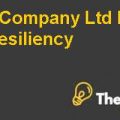
Venture Capital Method: Valuation Problem Set Case Solution
Question 1
It is concluded that the total number of shares that Bestafer would require would be 1.61 million with the share price of 3.12 given ifthe required rate of return would be 50% in all aspects. On the other hand, if the company would generate a required rate of 30%, then the total number of shares would be 1.97 million, which is a sharp decline in the numbers as compared to the 50% of required rate. Therefore, due to decline in the shares, it is concluded that the share price would be 7.49 at the end of the fifth year.
For part C, it is determined that if the company would require an additional 12 million of shares, then it has been identified that the venture capitalists would require 1.35 million of shares to execute the company’s operations by launching a new product in order to meet the overall demand.
Question 2
From the perception of Benedicta, it has been analyzed that with 15% of equity stacks heldby the management itself, the company would have the number of shares equal to 1.37 million where 0.52 million would be heldby the venture capitalist in case of 50% of the required rate of return. On the other hand, different situation would be facedby the company where 30% of required return would change the number of shares as well as the price. Therefore, in case of latter required return, it can be said that the number of shares would reduce to 1.7 million and thus, it would increase the shares price to 25 instead of only 9.
Question 3
Based on the situation of 3A and 3B, it can be said that the changes of the required shares and their price would be directly related to the use of required return, which the company would expect to generate. Thus, the increasedrequired rate would have more number of shares with less stock price and vice versa for the latter required rate whichis 30%.Therefore,from the following answers, it is concluded that 30% scenario would generateless number of shares with the price in addition to $9 per share as compared to the previous scenario.
Question 4
From the analysis, it is indicated that an effective rate of return would decline by 10% as compared to the proposed requirement to generate 50% of required rate of return. Thus, it is identified that the company would hold 40% of equity stake instead of more than 50%. If the company accepts the offer of Hybrid security, then it is determined that per share value would be 6.24 with total number of shares of 1.20 million. Therefore, it would require 40% of capital to meet the requirement of 50% required return.
On the other hand, the risk of using both the participating and standard dividends has an impact over the company’s performance to generate the net outcome. Participating shares are those shares, which would be equally divided among the shareholders based on the market return; they have also control in the company’s operations. Apart from that, the standard preferred shares are not subjected to hold the company’s stake, however they are only required to receive a particular amount of dividends at a specified period of time. Thus, it can be said that participating shareholders would allow the company to reduce the risk due to the fact that they would also have to face the loss...............
This is just a sample partial case solution. Please place the order on the website to order your own originally done case solution.












